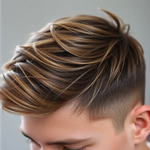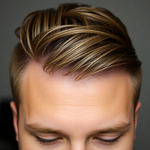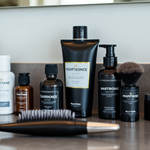
Sync Your Shade: How Semi-Permanent Hair Color Can Streamline an Eco-Friendly Men's Capsule Wardrobe
12 September 2025
Share
Struggling to look sharp, cut decision fatigue, and reduce waste in your style routine? Semi-Permanent Hair Color can be the low-commitment trick that ties an eco-friendly men’s capsule wardrobe together. This guide breaks down how to pick the right shade, maintain color sustainably, and build outfits that require fewer choices—so you look consistent, feel confident, and create less environmental impact.
Semi-Permanent Hair Color: The Smart Choice for Your Capsule
Semi-Permanent Hair Color deposits pigment on the hair shaft without the heavy lifting of permanent dyes. That means no harsh ammonia or extensive lifting, fewer touch-ups, and a fade that gives you flexibility rather than forcing a long-term commitment. For a capsule wardrobe—where cohesion and low-maintenance are king—semi-permanent color reduces mismatch anxiety and helps a small set of pieces read as a unified whole.
Why This Combo Works: Style, Time, and Sustainability
- Visual cohesion: A consistent hair shade creates a predictable frame for outfits, so neutrals and sustainable staples work together instantly.
- Lower chemical load: Semi-permanent formulas are often ammonia-free and require less frequent reapplication, which means less chemical runoff and fewer packaging cycles.
- Less time, fewer decisions: With less need to change your hair, you reduce both salon trips and daily outfit experimentation.
- Cost and carbon savings: Fewer salon visits and less product waste translate to direct financial and environmental benefits over the year.
How Semi-Permanent Hair Color Works (Simple Chemistry)
Semi-permanent dyes use direct pigments that sit on the outside of the hair shaft or penetrate slightly, bypassing the full chemical lift and oxidation process required by permanent color. Because they don't permanently alter the hair's structure, these dyes fade gradually with washes. That gradual fade is an advantage for capsule wardrobes: your hair ages into the look rather than forcing abrupt, repeated color sessions.
Choosing the Right Shade for Your Capsule
Picking the right shade is a mix of undertone matching, wardrobe analysis, and lifestyle fit. Use the steps below to land a choice you won’t regret.
- Audit your wardrobe palette. Spread your core pieces on the bed or floor. Are the dominant tones cool (navy, charcoal, black) or warm (olive, tan, camel)? Note any accent colors you wear regularly.
- Match undertones, not exact colors. If your closet skews cool, pick a neutral-to-ash semi-permanent shade. If you favor warm tones, warm chestnut or rich brown hues create harmony.
- Consider contrast level. Do you want hair that blends with your look (low contrast) or stands out (high contrast)? A low-contrast hair color simplifies outfits; a higher contrast color can add focal interest to minimalist wardrobes.
- Factor in maintenance. For busy guys or those prioritizing sustainability, choose a shade that fades naturally into your base color—mid-tones usually work best.
- Think seasonally—lightly. You can go slightly warmer for summer and slightly deeper for fall, but avoid frequent drastic changes; the goal is to reduce maintenance, not add more.
Shade Suggestions by Wardrobe Type
- Minimal Neutral Capsule (navy, white, gray): Ash brown or neutral brown. These shades pair cleanly with cool neutrals and fade gracefully.
- Earthy, Workwear Capsule (olive, tan, denim): Warm chestnut, soft copper, or medium brown. Enhances warm undertones in fabrics.
- Urban Monochrome Capsule (black, charcoal): Deep espresso or natural black-brown for a polished, modern frame.
- Accented Capsule with Burgundies/Blues: Neutral brown with subtle red or mahogany tones to register when you wear accents without clashing.
Sync Your Shade: Step-by-Step Application and Prep
- Do a strand and patch test. This checks color result and avoids allergic reactions. Follow product instructions exactly.
- Prep hair condition. Use a mild clarifying wash 24–48 hours before coloring to remove heavy product buildup, then condition lightly to avoid over-porosity.
- Apply in natural light. Use a mirror and daylight to gauge the true tone.
- Time it conservatively. Semi-permanent dyes often recommend 15–30 minutes. Less time yields subtler results; you can always deepen later.
- Rinse with cool water and use a sulfate-free shampoo. This preserves pigment and reduces runoff into wastewater.
At-Home vs Salon: Pros and Cons
- At-home: Lower cost, control over timing, and reduced travel emissions. Good for subtle adjustments and those with steady color goals. Requires following instructions carefully for safety and even results.
- Salon: Professional color matching and technique, better for complex looks or guys unsure about undertones. Consider a salon that uses low-impact brands and ask about eco-friendly disposal practices.
Maintenance Routine That Protects Color and the Planet
A low-impact maintenance routine extends color life, protects hair, and reduces waste:
- Wash 2–3 times per week with cool water; use a gentle, sulfate-free, biodegradable cleanser.
- Use a color-depositing conditioner or weekly tint mask to refresh tone without re-dying.
- Air-dry when possible; if you use heat, use a lower setting and a heat protectant to prevent premature fading from damage.
- Recycle product packaging and buy concentrated or refill formats when available to limit plastic waste.
Eco Impact: Why Semi-Permanent Can Be Greener
Semi-permanent color reduces the frequency of chemical processing, which can lower water and chemical consumption over time. Fewer salon visits also mean fewer car trips and associated emissions. While hair dye still involves packaged products and chemistry, choosing brands that disclose ingredients and offer refill options further minimizes the footprint.
For product safety and ingredient guidance, reputable health resources are useful—see WebMD for general info on hair dye safety and allergies: https://www.webmd.com/beauty/hair-dye.
Practical Wardrobe Strategies to Maximize the Effect
With your new shade locked in, use these tactics to make your capsule wardrobe do the heavy lifting:
- Limit your palette to 3–4 core colors. This reduces decision fatigue and ensures your hair tone won’t clash as you mix and match.
- Anchor outfits with a signature piece. A tailored jacket, quality knit, or durable chore coat becomes your outfit pivot and pairs reliably with your hair shade.
- Use texture, not color, to add interest. Knitwear, corduroy, and leather add depth without introducing new colors that could clash.
- Plan outfit combos in advance. Photograph 10 go-to looks and save them on your phone to speed morning decisions.
Styling Examples: Capsule Outfits That Play Well With Color
- Office-smart minimal: Ash brown hair + navy blazer + white oxford + slim charcoal trousers + clean leather shoes.
- Weekend rugged: Warm chestnut hair + olive chore jacket + white tee + dark denim + brown boots.
- City casual: Neutral brown hair + charcoal sweater + denim + Menll.com EcoSneak Casual Shoes for comfort and sustainable style.
Common Mistakes and How to Avoid Them
- Changing shades too often: Leads to over-processing and more waste. Stick to subtle shifts and give hair recovery time.
- Ignoring skin tone: A color that clashes with your skin undertone can undermine even the best wardrobe. Test and adjust.
- Using harsh products: Cheap ammonia-heavy dyes may be tempting but often increase damage and environmental harm.
Case Study: Three-Month Capsule Experiment
Picture this: Michael, 32, swaps a reactive color schedule for a neutral ash-brown semi-permanent shade and builds a 20-piece capsule dominated by navy, gray, and white. Result after 3 months: fewer outfit re-dos, one less weekly laundry load (thanks to deliberate outfit planning), and half the salon visits. He reports less decision fatigue and a perceived increase in outfit-quality because pieces harmonize with his hair instead of clashing.
Product Checklist: What to Buy (Sustainable Options)
- Semi-permanent dye from a brand with transparent ingredients and refill options.
- Color-depositing conditioner to stretch between applications.
- Sulfate-free, biodegradable shampoo and a deep-conditioning mask.
- Heat-protectant spray for occasional blow-drying.
- Small kit for at-home touch-ups: gloves, bowl, single-use applicator (reuse when possible), and a timer.
Where Menll.com Fits In
Looking for sustainable wardrobe anchors that pair effortlessly with a consistent hair shade? Menll.com’s outerwear collection offers durable, eco-minded jackets that sit well with neutral and warm hair tones alike. For casual days, the Menll.com EcoSneak Casual Shoes combine comfort and sustainable materials—useful building blocks for a low-waste capsule.
For more on building the right closet to match your lifestyle, our guide on creating a capsule wardrobe outlines how to pare down without losing style: https://menll.com/blog/how-to-build-capsule-wardrobe.
FAQ: Quick Answers
- How long does semi-permanent color last? Typically 4–8 weeks depending on wash frequency and product quality.
- Is it safe for sensitive scalps? Many formulas are gentler than permanent dyes, but perform a patch test and consult a dermatologist if you have a history of reactions.
- Can I go lighter with semi-permanent? Not effectively. Semi-permanent colors add tone but don’t lift natural pigment; to go lighter you need bleaching or a professional service.
Final Checklist: Start This Weekend
- Audit your wardrobe palette and pick a target shade that matches your dominant undertones.
- Buy a small semi-permanent kit and a color-depositing conditioner for upkeep.
- Plan five core outfits that work with the new shade and photograph them for easy mornings.
- Set a maintenance schedule: wash less, condition more, and refresh with a tint mask every 3–4 weeks.
Want to test the concept? Commit to one neutral hair shade and one 20-piece capsule for three months and track time, cost, and decision fatigue changes. Which shade are you thinking of trying? Drop your go-to color or ask for personalized recommendations in the comments below—let's trade tips.
Vorheriger Beitrag

Color as a Compass: Use Semi‑Permanent Hair Dye to Curate a Low‑Waste Men's Capsule Wardrobe
Aktualisiert am 13 September 2025
Nächster Beitrag

Semi-Permanent Hair Color: A Low-Waste Strategy for a Seasonless Men's Capsule Wardrobe
Aktualisiert am 11 September 2025





